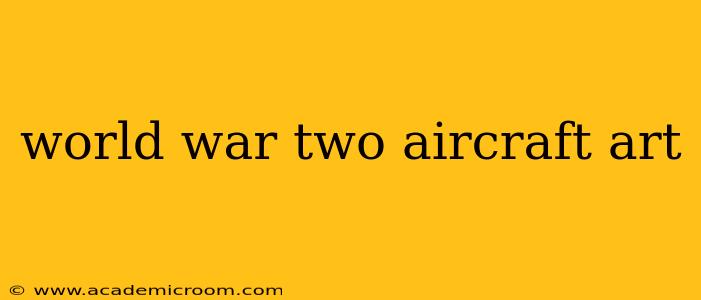World War II. The very name conjures images of epic battles, unwavering courage, and devastating loss. But beyond the historical accounts and grainy newsreel footage lies a rich tapestry of artistic expression—a testament to the human experience amidst the chaos of war. World War II aircraft art captures the spirit of the era, memorializing iconic planes, heroic pilots, and the intense emotional landscape of a global conflict. This exploration delves into the diverse styles, motivations, and impact of this compelling art form.
What Makes World War II Aircraft Art Unique?
World War II aircraft art isn't simply a depiction of planes; it's a reflection of the time's technological advancements, the human drama unfolding in the skies, and the profound impact of war on individuals and nations. The art often showcases the sleek, powerful machines themselves, emphasizing their speed, agility, and destructive capabilities. But equally prominent are the human stories – the brave pilots, the ground crews, and the civilians affected by the conflict. The art often reflects the artist's personal experiences, perspectives, and emotional responses to the war.
What are the Different Styles of World War II Aircraft Art?
The styles employed in World War II aircraft art are as diverse as the artists who created them. We see everything from realistic portrayals capturing intricate details of aircraft and battle scenes to more abstract expressions conveying the emotions and psychological impact of war. Popular styles included:
- Realism: Meticulously detailed paintings and drawings accurately depicting aircraft, landscapes, and battle sequences. These often served as historical records or promotional materials.
- Impressionism: Capturing the atmosphere and mood of aerial combat through brushstrokes and color palettes, emphasizing the dynamism and energy of the scenes.
- Propaganda Art: Used by governments to promote patriotism, bolster morale, and demonize the enemy. These often depicted triumphant scenes or showcased the superior technology of their aircraft.
- Modernism & Abstract Expressionism: Post-war artists often explored the psychological trauma and consequences of war through abstract and symbolic representations.
What are Some Famous Examples of World War II Aircraft Art?
Many artists contributed to the body of World War II aircraft art, creating iconic works that remain celebrated today. While pinpointing specific, universally "famous" examples is difficult without specifying a region or artist, several categories and themes stand out:
- Nose Art: Often painted on the noses of aircraft, this art ranged from pin-up girls and humorous cartoons to personalized messages and symbols. These provided a sense of individuality and camaraderie among aircrews.
- War Bonds Posters: Featuring powerful imagery of aircraft and pilots, these posters played a crucial role in rallying public support for the war effort.
- Combat Paintings and Drawings: Created by official war artists or individual pilots and airmen, these provided firsthand accounts of air battles and the experiences of those involved.
How Did World War II Aircraft Art Influence Later Art Movements?
The experience of war, as depicted in World War II aircraft art, had a profound impact on subsequent art movements. The trauma and psychological effects of the conflict influenced the themes and styles of postwar artists, leading to movements exploring themes of alienation, existentialism, and the human condition. Many artists continued to draw inspiration from the power and beauty of aircraft, using them as symbols in their work.
Where Can I Find World War II Aircraft Art?
World War II aircraft art can be found in various places:
- Museums: Many aviation and military museums showcase collections of original artwork and related artifacts.
- Private Collections: Numerous private collectors own and cherish these works.
- Online Galleries and Auction Houses: A growing number of online platforms specialize in selling and showcasing historical artwork, including World War II aviation pieces.
- Books and Publications: Numerous books and magazines are dedicated to showcasing and documenting World War II aircraft art.
Is World War II Aircraft Art Still Relevant Today?
Yes, absolutely! World War II aircraft art remains incredibly relevant for several reasons:
- Historical Record: It provides a visual record of a pivotal moment in history, capturing the technological advancements and the human cost of war.
- Emotional Connection: It allows us to connect with the experiences of those who lived through the conflict, offering insights into their fears, hopes, and resilience.
- Artistic Merit: Many pieces are stunning works of art, showcasing the talent and skill of the artists who created them.
- Memorialization: The art serves as a lasting memorial to those who fought and died during the war.
By studying World War II aircraft art, we gain a deeper understanding not only of the conflict itself but also of the human spirit’s ability to create beauty and meaning even amidst unimaginable hardship. It's a testament to the enduring power of art to reflect, interpret, and transmit the complexities of human experience across generations.
